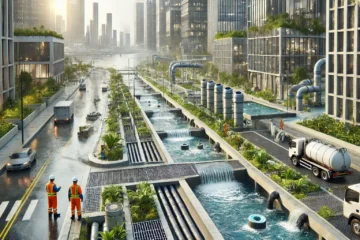Underground Cables: A Comprehensive Overview
Underground cables are an integral component of modern electrical infrastructure, providing an efficient and reliable means of transmitting and distributing electricity below the Earth’s surface. Unlike overhead lines, underground cables are less exposed to external factors, making them an attractive option for urban and environmentally sensitive areas. This blog explores the design, types, applications, advantages, challenges, and future trends of underground cables.
What Are Underground Cables?
Underground cables are insulated power transmission lines designed to carry electricity beneath the ground. They are used in various settings, including urban areas, industrial facilities, and renewable energy projects, to minimize visual impact and enhance reliability.
Components of Underground Cables
- Conductor
- Made from materials like copper or aluminum for efficient electricity conduction.
- Insulation
- Protects the conductor from direct contact with the ground and minimizes energy loss. Common materials include cross-linked polyethylene (XLPE) and paper-oil insulation.
- Sheathing
- Provides an additional protective layer against moisture, mechanical damage, and chemical reactions.
- Armoring
- Adds mechanical strength to withstand external stresses, such as soil pressure and construction activities.
- Outer Covering
- Serves as the final protective barrier, often made from polyethylene or PVC.
Types of Underground Cables
- Low-Voltage Cables
- Used for residential and light commercial applications.
- Medium-Voltage Cables
- Commonly employed in industrial facilities and urban distribution systems.
- High-Voltage Cables
- Designed for power transmission over long distances, often connecting substations or renewable energy farms to the grid.
- Extra-High Voltage (EHV) and Ultra-High Voltage (UHV) Cables
- Specialized for critical infrastructure, such as connecting power plants to national grids.
Applications of Underground Cables
- Urban Areas
- Minimize visual clutter and maximize land use efficiency.
- Suitable for high-density cities where overhead lines are impractical.
- Renewable Energy
- Connect offshore wind farms and solar parks to the main grid.
- Industrial Zones
- Power heavy machinery and ensure uninterrupted supply in industrial facilities.
- Environmentally Sensitive Areas
- Protect natural landscapes and reduce the ecological impact.
Advantages of Underground Cables
- Reliability
- Less vulnerable to weather conditions, such as storms, lightning, and heavy winds.
- Aesthetic Appeal
- No visual obstructions, preserving urban and natural landscapes.
- Safety
- Reduced risk of accidental electrocution or interference.
- Low Maintenance
- Minimal exposure to environmental damage leads to fewer maintenance requirements.
- Longevity
- Well-designed underground systems can last decades.
Challenges of Underground Cables
- High Initial Costs
- Installation and material costs are significantly higher than overhead lines.
- Complex Installation
- Requires specialized equipment and skilled labor for trenching, laying, and jointing.
- Limited Load Capacity
- Heat dissipation is less effective compared to overhead lines, limiting current-carrying capacity.
- Maintenance and Fault Detection
- Locating and repairing faults in underground cables is more challenging and time-consuming.
- Environmental Impact
- Installation can disturb the local ecosystem and require extensive planning to mitigate.
Installation Process
- Route Selection
- Detailed surveys to identify optimal paths while avoiding existing utilities and minimizing environmental disruption.
- Trenching and Excavation
- Digging trenches of appropriate depth to lay the cables securely.
- Cable Laying
- Ensuring cables are laid without bending or damaging the insulation.
- Backfilling and Compaction
- Covering the cables with suitable material to protect against mechanical damage.
- Testing and Commissioning
- Verifying electrical integrity before energizing the system.
Future Trends in Underground Cables
- Advanced Materials
- Development of high-performance insulation and conductive materials to enhance efficiency and durability.
- Smart Monitoring Systems
- Use of sensors and IoT devices to monitor cable health and predict potential failures.
- HVDC Technology
- High Voltage Direct Current (HVDC) cables are gaining popularity for long-distance, high-capacity transmission.
- Eco-Friendly Practices
- Adoption of sustainable practices in manufacturing and installation to minimize environmental impact.
- Integration with Renewable Energy
- Expansion of underground cable networks to support the growth of renewable energy infrastructure.
Conclusion
Underground cables are a critical component of modern power systems, providing a reliable and visually unobtrusive solution for electricity transmission and distribution. While challenges like high costs and complex maintenance persist, advancements in technology and materials are paving the way for more efficient and sustainable underground cable systems. With urbanization and renewable energy projects on the rise, underground cables will play an increasingly vital role in shaping the future of electrical infrastructure.


